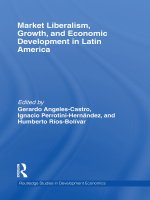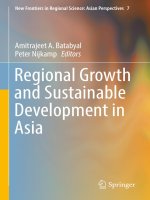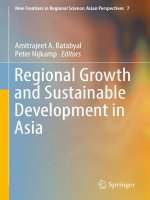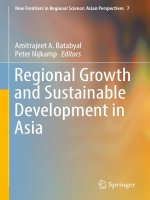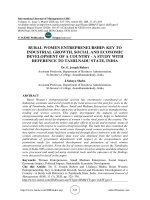Economic growth and economic development 91
Bạn đang xem bản rút gọn của tài liệu. Xem và tải ngay bản đầy đủ của tài liệu tại đây (131.48 KB, 1 trang )
Introduction to Modern Economic Growth
CES production function becomes linear, i.e.
Y (t) = γAH (t) AK (t) K (t) + (1 − γ) AH (t) AL (t) L (t) .
Finally, as σ → 0, the CES production function converges to the Leontief production
function with no substitution between factors,
Y (t) = AH (t) min {γAK (t) K (t) ; (1 − γ) AL (t) L (t)} .
The special feature of the Leontief production function is that if γAK (t) K (t) 6=
(1 − γ) AL (t) L (t), either capital or labor will be partially “idle” in the sense that
a small reduction in capital or labor will have no effect on output or factor prices.
The reader will be asked to work through the implications of the CES production
function in Exercise 2.13.
2.5.1. A First Look at Sustained Growth. Can the Solow model generate
sustained growth without technological progress? The answer is yes, but only if we
relax some of the assumptions we have imposed so far.
The Cobb-Douglas example above already showed that when α is close to 1,
adjustment of the capital-labor ratio back to its steady-state level can be very slow.
A very slow adjustment towards a steady-state has the flavor of “sustained growth”
rather than the economy settling down to a stationary point quickly.
In fact, the simplest model of sustained growth essentially takes α = 1 in terms of
the Cobb-Douglas production function above. To do this, let us relax Assumptions
1 and 2 (which do not allow α = 1), and suppose that
(2.38)
F [K (t) , L (t) , A (t)] = AK (t) ,
where A > 0 is a constant. This is the so-called “AK” model, and in its simplest
form output does not even depend on labor. The results we would like to highlight
apply with more general constant returns to scale production functions, for example,
(2.39)
F [K (t) , L (t) , A (t)] = AK (t) + BL (t) ,
but it is simpler to illustrate the main insights with (2.38), leaving the analysis of
the richer production function (2.39) to Exercise 2.12.
Let us continue to assume that population grows at a constant rate n as before
(cfr. equation (2.31)). Then, combining this with the production function (2.38),
77
